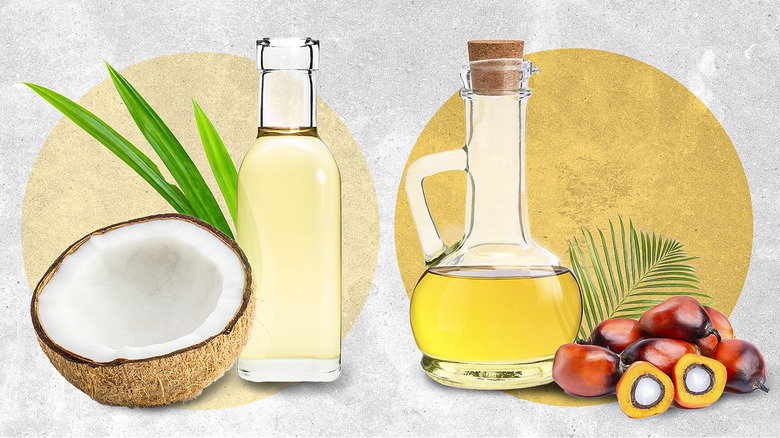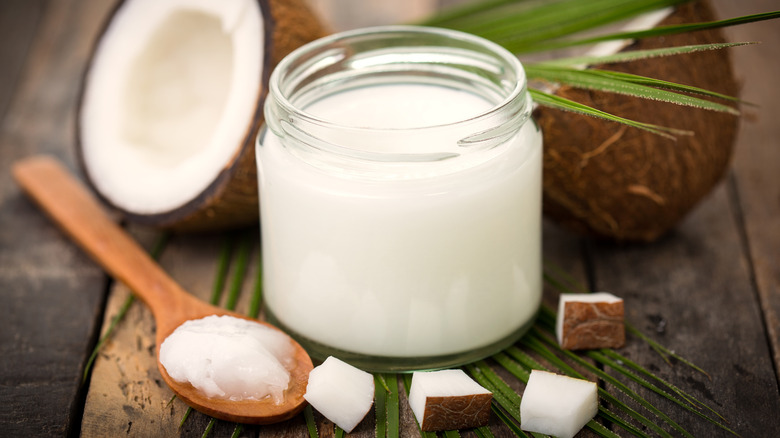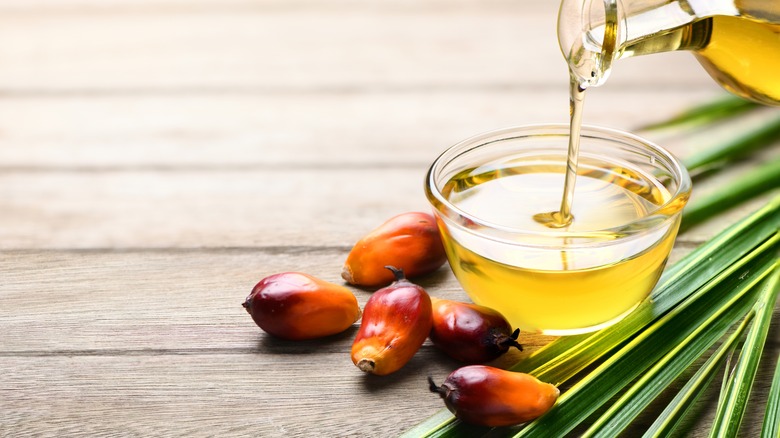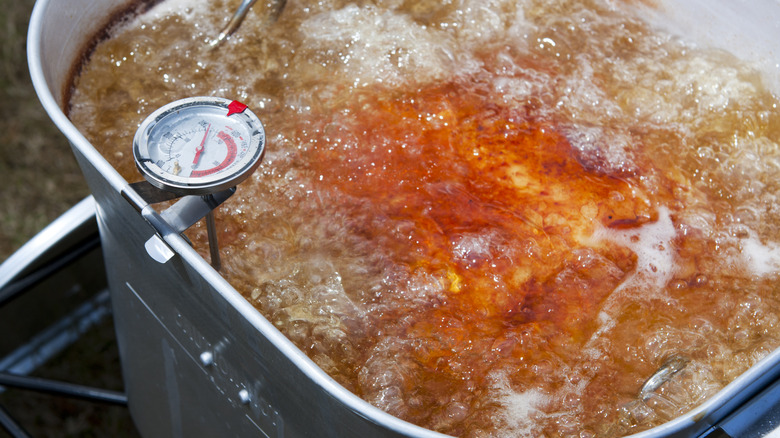The Difference Between Using Coconut Vs. Palm Oil In Cooking
Oil is a necessity in the kitchen, but with so many options, it can be difficult to keep track of the differences between them. Palm oil and coconut oil are two of the most popular available to home chefs. If you're confused as to why someone would choose one over the other you're in good company. The internet contains a wealth of information, but it can still be difficult to parse out fact from fiction — and the debate over which cooking oil works best and is best for you ranks among the top in the food world.
Oil has a bad reputation for being an outsized source of fat but you can't really cook without it. By picking a healthier option we hope to minimize the downsides of our oil consumption. But even this narrative is up for debate since healthy fats are an important part of a good diet. Let's dive in.
What is coconut oil?
Coconut oil comes from, you guessed it, coconuts, and you can buy it either refined or unrefined. Unrefined coconut oil, aka virgin coconut oil, is made by pressing the nut meat, without undergoing intense filtration, bleaching, and deodorizing. Refined coconut oil undergoes a series of separate steps that make the coconut oil more capable of handling higher temperatures but the coconut flavor and scent are usually lost in the process. That may or may not be a good thing depending on what you are using it for. Partially hydrogenated coconut oil is the most processed version and is considered the least healthy of the three, though it does have a longer shelf life. You can't buy partially hydrogenated coconut oil anymore since hydrogenated oils were banned in the U.S. in 2018.
The strange thing about coconut oil is that no one seems to agree on how healthy it is. The New York Times did a survey in 2016 that asked the public and experts what foods they thought were healthy; 72% of people thought coconut oil was healthy while 37% of nutritionists thought the same. It was the second-largest variance between expert and public perception. When nutritionists express the view that coconut oil is unhealthy, they are referring to the saturated fats coconut oil contains — more on that in a second.
What is palm oil?
Palm oil is one of the least expensive and most widely used of the plant oils. It's made from palm fruit which originally came from Africa. You can also buy palm kernel oil, which is from the seed of the palm fruit, but that's a different product. Much like coconut oil, you can buy unrefined or refined palm oil. The differences between them are very similar. Unrefined palm oil is reddish in color and has a stronger aroma, whereas refined palm oil is neutral. Unrefined palm oil also has a lower smoke point relative to refined palm oil.
Thanks to its low cost and wide availability, palm oil is used in many packaged foods. It's eaten all over the world, though there have been several vocal environmental movements that have decried the deforestation that has occurred due to palm oil's rising popularity. The vast majority of palm oil comes from Indonesia and Malaysia, though it's grown in southwestern Africa and in South America as well.
Chewing the fat
Oils aren't a great source of anything except fat. When we say that one oil is healthier than another, we are largely talking about what kinds of fat the oil is made of. Coconut oil is almost entirely saturated fat, sitting around the 85% mark. Palm oil is 50% saturated fat, 40% monounsaturated fat, and 10% polyunsaturated fat. Saturated fats are solid at room temperature, and because palm oil is a blend remains semi-solid at room temperature while coconut oil is completely solid.
The official 2020–2025 Dietary Guidelines for Americans recommends limiting our saturated fat intake to less than 10% of our daily calories. They favor monounsaturated and (even better) polyunsaturated fats instead. Since coconut oil is so full of saturated fat, many nutritionists recommend against using it to avoid adverse health consequences. And in this sense, palm oil does contain healthier fats.
A counterpoint, according to Healthline is that coconut oil seems to boost both good and bad fats in the body — the former having protective health features, and the latter detrimental ones. One upside for coconut oil is that it is decidedly healthier than consuming animal fats, and has a closer consistency to tallow or lard which is crucial for certain kinds of preparations. It is the case of both fats, the more refined they are, the worse the fat content becomes relative to the total amount used, so opt for the unrefined as long as it works for your dish.
The smoke point matters
The smoke point refers to the temperature a particular type of oil can get to before it starts to smoke. Oil that's heated past its smoke point starts to create free radicals and other unhealthy consequences. It also starts to taste bad. An oil with a low smoke point isn't as versatile as an oil with a high smoke point. Manufacturers can increase an oil's smoke point by refining it, at the cost of turning healthy fats into less healthy fats.
Unrefined coconut oil has a smoke point of about 350 degrees Fahrenheit, which is pretty low. Refined coconut oil has a smoke point of 400 degrees. These temperatures mean that coconut oil is good for baking and most forms of shallow pan frying. Refined palm oil has a smoke point of 450 degrees which makes palm oil incredibly versatile. Palm oil is the oil of choice for most deep fryers because of this high smoke point but it also makes for excellent pan frying as well.




